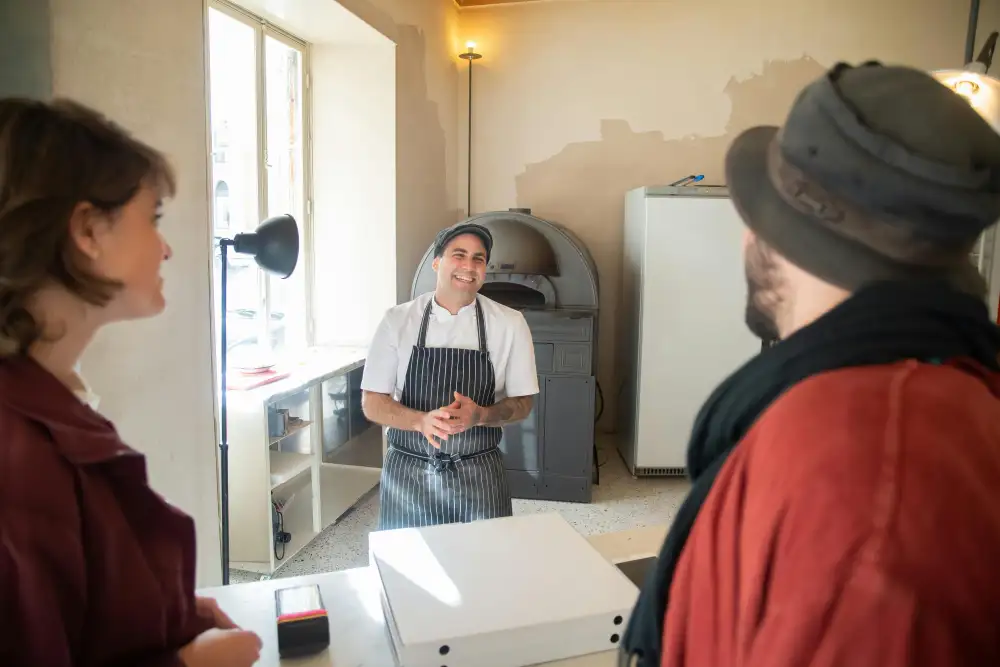Unleashing the Power of a Convection Oven: Elevate Your Home Cooking Experience

In the world of modern cooking, convection ovens have emerged as a game-changer. These innovative appliances have revolutionized the way we cook at home, providing faster and more efficient results. Whether you are a seasoned chef or an amateur cook, incorporating a convection oven into your kitchen can elevate your culinary experience to new heights.
Unlike traditional ovens that rely on radiant heat, convection ovens utilize a fan and exhaust system to circulate hot air evenly throughout the cooking chamber. This constant circulation of hot air ensures that food is cooked more quickly and uniformly. The result? Crispy exteriors, succulent interiors, and perfectly baked goods every time.
But what sets convection ovens apart from their conventional counterparts? And how can they enhance your home cooking experience? Let's delve deeper into the workings of these remarkable appliances and explore their myriad benefits.
Explanation of how convection ovens work
A convection oven is a powerful tool that can revolutionize your cooking experience at home. Unlike traditional ovens, which rely on radiant heat to cook food, convection ovens use a fan and exhaust system to circulate hot air evenly throughout the oven cavity.
The fan in a convection oven helps to distribute heat more efficiently, ensuring that food cooks faster and more evenly. This constant circulation of hot air also means that you can cook multiple dishes at once without worrying about flavors mixing or uneven cooking.
Convection ovens work by creating a consistent temperature throughout the oven cavity. The fan draws in cool air from the room, heats it up using an electric element or gas burner, and then circulates it back into the oven. As the hot air moves around the food, it transfers heat more quickly than in a traditional oven.
This rapid transfer of heat not only speeds up cooking times but also creates a crispier exterior on foods like roasted meats or baked goods. The circulating air helps to remove moisture from the surface of the food, resulting in a golden brown crust while keeping the inside moist and tender.
In addition to faster cooking times and improved browning, convection ovens also offer better energy efficiency compared to traditional ovens. Because they cook food more quickly, you can reduce cooking temperatures by about 25 degrees Fahrenheit (14 degrees Celsius) and still achieve the same results. This energy-saving feature can lead to significant cost savings over time.
Overall, understanding how convection ovens work allows you to harness their power for superior cooking results. By utilizing this technology effectively, you can elevate your culinary creations to new heights in your own kitchen.
Benefits of using a convection oven at home
Using a convection oven at home offers numerous benefits that can elevate your cooking experience. Firstly, the even distribution of heat in a convection oven ensures that your food cooks more quickly and evenly. This means no more burnt edges or undercooked centers. Secondly, convection ovens are known for their ability to retain moisture, resulting in juicier meats and perfectly baked goods. Additionally, the circulating hot air in a convection oven allows for faster cooking times, making it ideal for busy individuals or families. Lastly, using a convection oven can also save energy as it requires lower temperatures and shorter cooking times compared to traditional ovens. Overall, incorporating a convection oven into your home kitchen will enhance the quality of your dishes and make your cooking process more efficient.
Tips for using a convection oven effectively
1. Adjust cooking time and temperature: Convection ovens cook food faster than traditional ovens due to the circulation of hot air. Reduce the cooking time by 25% and lower the temperature by about 25 degrees Fahrenheit.
2. Use shallow pans: To ensure proper airflow, use shallow pans instead of deep ones. This allows the hot air to circulate evenly around the food, resulting in a more even and crispy texture.
3. Avoid overcrowding: Leave enough space between food items to allow the hot air to circulate freely. Overcrowding can lead to uneven cooking and longer cooking times.
4. Use low-sided baking sheets: Opt for low-sided baking sheets or rimless pans when baking cookies or pastries in a convection oven. This promotes better browning and ensures even heat distribution.
5. Monitor food closely: Keep an eye on your food while it's cooking in a convection oven as it may cook faster than expected. Use a timer and check for doneness periodically to avoid overcooking.
6. Rotate pans halfway through cooking: For more uniform results, rotate the position of your pans halfway through the cooking process. This helps compensate for any uneven heat distribution within the oven.
7. Reduce recipe temperatures: When using recipes designed for traditional ovens, reduce the recommended temperature by approximately 25 degrees Fahrenheit when using a convection oven.
By following these tips, you can maximize the efficiency of your convection oven and achieve delicious results with every dish you prepare.
Comparison between convection ovens and traditional ovens
When it comes to cooking appliances, the debate between convection ovens and traditional ovens is a hot topic. Let's compare these two options to help you make an informed decision.
Convection ovens use a fan and exhaust system to circulate hot air evenly throughout the oven cavity. This results in faster and more even cooking, as the hot air surrounds the food from all angles. Traditional ovens, on the other hand, rely on radiant heat that emanates from heating elements at the top and bottom of the oven.
The main advantage of convection ovens is their ability to cook food faster than traditional ovens. The circulating hot air reduces cooking time by up to 25%, allowing you to whip up meals in a jiffy. Additionally, convection ovens provide more even browning and can handle multiple racks of food simultaneously without sacrificing quality.
Another benefit of convection ovens is their versatility. They excel at baking, roasting, and broiling, making them ideal for a wide range of recipes. Whether you're baking cookies or roasting a turkey, a convection oven will deliver consistent results with its efficient heat distribution.
Traditional ovens have their own advantages too. They are simpler to operate and require less maintenance compared to convection ovens. Moreover, some delicate dishes like custards or soufflés may prefer the gentle heat of a traditional oven over the intense airflow of a convection oven.
In conclusion, both convection and traditional ovens have their merits depending on your cooking needs and preferences. If speed, even cooking, and versatility are important to you, then investing in a convection oven is worth considering. However, if simplicity and gentler heat are your priorities, sticking with a traditional oven may be the better choice. Ultimately, it boils down to personal preference and what works best for your culinary adventures in the kitchen.
Popular recipes that can be prepared using a convection oven
Popular recipes that can be prepared using a convection oven are endless, thanks to its ability to cook food faster and more evenly. Roasting meats such as chicken, turkey, and beef is a breeze in a convection oven, resulting in juicy and tender meat with a crispy exterior. Baking cookies, cakes, and breads also yield excellent results due to the even heat distribution. Additionally, convection ovens are perfect for making perfectly golden and crispy pizzas with a perfectly cooked crust. The possibilities are truly endless when it comes to experimenting with different recipes in a convection oven.
Maintenance and cleaning tips for convection ovens
Maintenance and cleaning are essential to ensure the longevity and optimal performance of your convection oven. Here are some tips to help you keep your oven in top shape:
1. Regularly clean the interior of the oven using a mild detergent and warm water. Avoid abrasive cleaners or scrub brushes that can damage the oven's surface.
2. Remove any excess food particles or spills immediately after use to prevent them from burning onto the oven walls or heating elements.
3. Clean the oven racks separately by soaking them in warm, soapy water. Use a soft sponge or cloth to remove any stubborn stains or residue.
4. Check and clean the oven's fan regularly as it can accumulate grease and debris over time, affecting its efficiency. Refer to your manufacturer's instructions for guidance on how to access and clean the fan.
5. Clean the exterior of the oven with a damp cloth and mild detergent. Avoid using harsh chemicals or abrasive materials that may scratch or damage the surface.
6. Inspect and replace any damaged seals or gaskets around the door to ensure proper heat retention and energy efficiency.
7. Schedule professional maintenance at least once a year to address any potential issues, such as faulty thermostats or malfunctioning fans.
By following these maintenance and cleaning tips, you can enjoy hassle-free cooking experiences with your convection oven for years to come!
In conclusion, incorporating a convection oven in your home kitchen can truly elevate your cooking experience. The powerful and efficient airflow of a convection oven ensures even cooking and browning, resulting in deliciously crispy and evenly cooked dishes. With faster cooking times and energy-saving capabilities, it is a practical choice for busy individuals. Whether you're baking, roasting, or broiling, the versatility of a convection oven allows for endless culinary possibilities. By following the tips for effective use and maintaining proper cleaning practices, you can enjoy the benefits of this modern appliance for years to come. Upgrade your home kitchen with a convection oven and unleash its power to create delectable meals that will impress your family and friends.
Published: 07. 02. 2024
Category: Home



